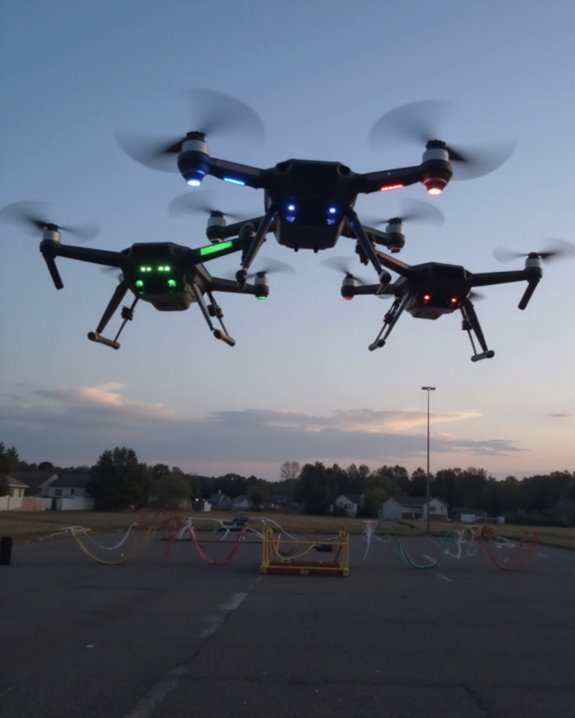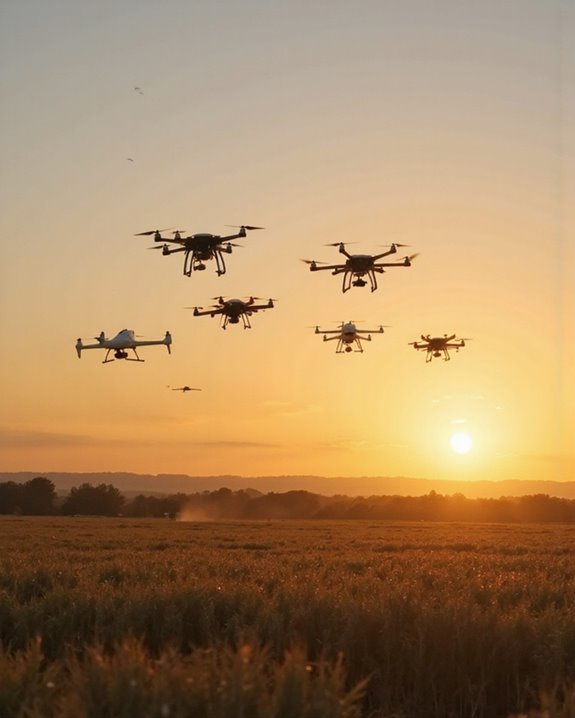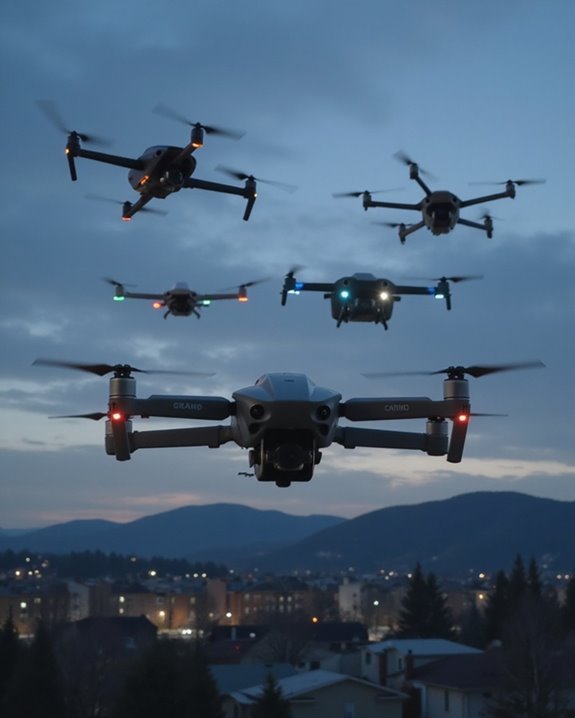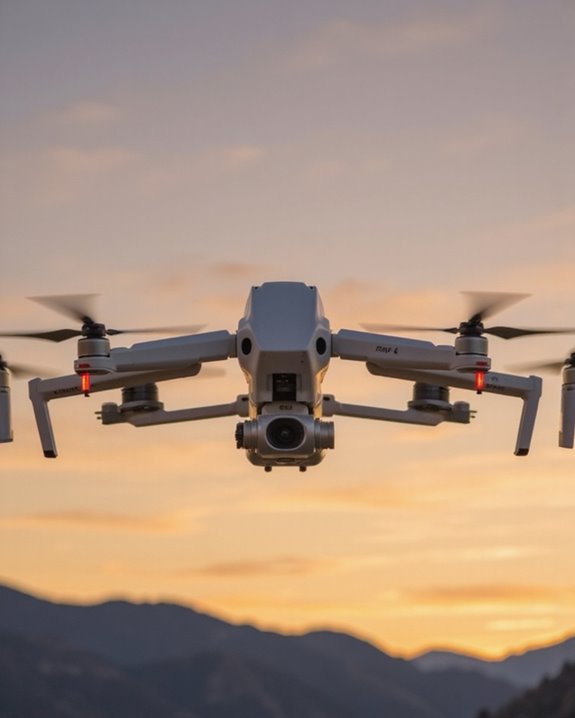Looking for a cutting-edge programmable drone? The TizzyToy MT002-Pro leads the pack with an impressive 40-minute flight time and 4K camera, while the nimble Loiley model offers user-friendly 2K imaging perfect for beginners. For professional-grade performance, DJI’s Mini 4K delivers unmatched 93-minute extended flights and premium stabilization. These top performers of 2025 each bring unique strengths to the table, from advanced obstacle avoidance to gesture controls – and we’re just getting started with the technical specs!
Key Takeaways
- Advanced drones with programmable features should offer optical flow positioning and altitude hold for stable automated flight patterns.
- Brushless motors are essential for programmable drones, providing better efficiency and longevity for repeated autonomous missions.
- Long flight times of 30+ minutes per battery enable complex programming sequences and extended autonomous operations.
- Reliable transmission range of at least 4km ensures uninterrupted connectivity during programmed flight paths.
- Smart features like gesture controls and obstacle avoidance are crucial for executing pre-programmed routines safely.
Brushless Motor Drone with 4K Camera and 40min Flight Time
- 【4K Ultra HD Quality & Real-time Transmission, 90-degree Adjustable Shock-absorbing Camera, 4000 Feet Control Distance】Our drone offers 4k resolution for photo taking...
- 【40-minute Endurance Battery, Accessible Accessories】Our drone is furnished with two reliable batteries, enabling a maximum flight duration of 40 minutes. Should you...
- 【Brushless Motor, Precise Optical Flow Positioning, Dependable Air Pressure Altitude Hold】Our drone is equipped with a substantial brushless motor, which ensures...
The TizzyToy MT002-Pro drone packs quite a punch for photography enthusiasts and aspiring aerial filmmakers who don’t want to break the bank! You’ll capture stunning aerial shots with its 4K Ultra HD camera, which features a 90-degree adjustable shock-absorbing mount and impressive 4000-foot control range. The brushless motor delivers smooth, stable flight for up to 40 minutes using the two included batteries.
You’ll love the smart features that make flying a breeze – optical flow positioning, indoor obstacle avoidance, and altitude hold keep you steady while gesture controls let you snap photos with a wave! Whether you’re a beginner or pro, three speed settings and 360-degree flip capabilities guarantee you’ll have a blast exploring the skies.
Best For: Photography and drone enthusiasts seeking a feature-rich, mid-range drone with excellent camera capabilities and extended flight time without spending premium prices.
Pros:
- Impressive 40-minute total flight time with two included batteries provides extended filming sessions
- High-quality 4K camera with 90-degree adjustment and shock absorption for stable aerial photography
- Smart features like optical flow positioning, obstacle avoidance, and gesture controls make it accessible for beginners
Cons:
- 4000-foot control range, while good, falls short of premium drones that offer longer ranges
- Plastic construction may not be as durable as more expensive models
- Limited customer review history with only 214 ratings to validate long-term reliability
Drone with Camera, 2K HD FPV with Altitude Hold (2 Batteries)
Adventure seekers looking for their first high-quality drone will love this feature-packed Loiley model that combines portability with impressive specs! You’ll get crystal-clear 2K HD footage through the 90° adjustable camera, and the real-time FPV view lets you share those epic shots directly to social media.
The drone’s intelligent flight controls make piloting a breeze – just tap for takeoff and landing while altitude hold keeps things steady. At under 250g and folding down to just 5 x 3 x 2 inches, it’s your perfect travel buddy! The dual batteries give you a solid 26 minutes of total flight time, and with propeller guards included, you won’t have to worry about those “oops” moments during training.
Best For: Beginner drone enthusiasts and casual photographers seeking an affordable, user-friendly drone with good image quality and portable design for travel and outdoor recreation.
Pros:
- Lightweight and compact folding design makes it highly portable and requires no FAA registration
- User-friendly features like one-key takeoff/landing and altitude hold make it easy for beginners
- Includes two batteries for extended flight time and complete safety features package
Cons:
- Individual battery life of 6-8 minutes per charge is relatively short
- 2K camera, while good, isn’t top-tier compared to more expensive drones
- Limited customer review history with only 19 ratings available
DJI Mini 4K Drone with UHD Camera
- No Registration Needed - Under 249 g, this drone with camera for adults 4K does not require FAA registration or Remote ID for recreational use. Visit the FAA's official...
- 4K Ultra HD & 3-Axis Gimbal for Cinematic Quality Shooting - Capture stunning moments in any light—sunrises, sunsets, and night scenes with crystal-clear 4K resolution....
- 38kph (Level 5) Wind Resistant - This drone for adults has a stable flight even in Level 5 winds. Brushless motors enhance power and allow takeoff at altitudes up to...
Weighing just 246 grams, DJI’s Mini 4K drone proves itself perfect for travel enthusiasts and beginners who don’t want the hassle of FAA registration. You’ll love the impressive 31-minute flight time per battery, and with the option to use up to three batteries, you can keep flying for over 90 minutes! The 4K UHD camera with 3-axis gimbal stabilization delivers stunning footage even in Level 5 winds.
The drone’s 10km transmission range and GPS return-to-home feature guarantee you won’t lose your little flying friend. With one-tap takeoff and landing, plus stable hovering in winds up to 38kph, you’ll feel like a pro pilot in no time – and at $239, it’s quite the steal!
Best For: Amateur photographers, travel enthusiasts, and beginners seeking a lightweight, registration-free drone with professional-quality 4K video capabilities and extended flight time.
Pros:
- Lightweight design under 249g eliminates need for FAA registration
- Impressive 31-minute flight time per battery with option to extend up to 93 minutes with additional batteries
- Advanced features like GPS return-to-home and 3-axis stabilization ensure safe, stable footage even in strong winds
Cons:
- Requires DJI Fly app download from official website due to compatibility issues
- Single battery included – additional batteries sold separately
- Limited to slower speeds (17 kph) compared to larger drones in windless conditions
Factors to Consider When Choosing a Programmable Drone

When you’re ready to choose your perfect programmable drone, you’ll want to focus on several key features that can make or break your flying experience. Factors like flight time, camera quality, and reliable connectivity will determine if you’re capturing stunning aerial footage or watching your drone become an expensive paperweight! Your ideal choice will depend on balancing practical elements like size restrictions and motor power with your specific needs, whether you’re an aspiring cinematographer or a coding enthusiast looking to experiment with drone automation.
Flight Time and Battery
The flight time and battery life of your programmable drone can make or break your coding adventures in the sky! You’ll want to look for models that offer at least 20-30 minutes of flight time per battery charge, and don’t forget – having spare batteries on hand is a game-changer.
Most modern programmable drones come equipped with batteries ranging from 1000 mAh capacity and up, giving you plenty of time to perfect those automated flight patterns. Keep an eye out for drones with smart battery features like low-power warnings and quick-swap capabilities – there’s nothing worse than your drone landing mid-sequence! You can maximize your coding sessions by using multiple batteries, potentially extending your flight time up to 93 minutes. Just think of all the aerial choreography you’ll master with that kind of airtime!
Camera Resolution Quality
Sharp, crystal-clear imagery makes all the difference in your aerial photography and coding projects! When selecting your programmable drone, you’ll want to prioritize models featuring 4K resolution cameras that capture stunning detail in both photos and videos.
Look for drones equipped with advanced CMOS sensors – they’re your best friends for those tricky low-light shots and vivid color accuracy. You’ll appreciate how 12MP or higher cameras let you zoom in without losing quality (no more pixelated footage of your backyard adventures!). Many top models now combine 4K capability with 3-axis stabilization, ensuring your aerial masterpieces stay blur-free even when you’re pushing your drone’s programming limits. Whether you’re capturing data for coding projects or shooting spectacular aerial views, higher resolution means better results every time.
Range and Connectivity
Getting maximum range and reliable connectivity from your programmable drone can make the difference between an awesome flight and a nerve-wracking experience! You’ll want to look for drones that offer robust wireless connectivity, with many top models now reaching impressive distances of up to 4 kilometers in real-world conditions.
Don’t let those flashy “10-kilometer range” claims fool you – your actual distance will depend heavily on your environment. Buildings, trees, and even that pesky weather can cut your range down to size! That’s why you’ll want to focus on models with strong anti-interference features and reliable signal stability. Look for drones that operate on advanced frequency bands, and remember: while Wi-Fi connectivity is great for real-time control and video feeds, it’s just one piece of the connectivity puzzle.
Size and Weight Limits
Size and weight considerations pack a powerful punch when selecting your perfect programmable drone! You’ll want to think carefully about these essential specs, as they’ll determine both where and how you can fly your new robotic companion.
For hassle-free flying, you’ll love drones under 250 grams – they’re registration-free and perfect for beginners! These lightweight champions also tend to stay airborne longer, giving you more time to perfect those programming sequences. If you’re planning to code indoor flight patterns, look for compact models under 10 inches across (unless you enjoy playing drone dodge-ball with your furniture!). For outdoor adventures, heavier drones over 500 grams offer rock-solid stability in the wind, but remember – they’ll need proper registration. Don’t forget to check those folded dimensions if you’re planning to take your drone on the go!
Motor Type and Power
Motor power and type stand at the heart of every great programmable drone, much like how weight affects its agility! You’ll want to prioritize brushless motors, which deliver superior efficiency and longevity compared to their brush-laden cousins – trust me, those little brushes can be quite the troublemakers!
When it comes to power ratings, don’t skimp on the watts. A robust motor system can keep your drone airborne for up to 40 minutes with multiple batteries and battle winds up to 38 kph – that’s like flying through a cat’s sneeze! Plus, higher power ratings support advanced features like optical flow positioning for precise hovering. You’ll zip around at speeds reaching 17 kph, perfect for those programming projects where you need both stability and responsiveness in your aerial companion.
Control System Features
The control system serves as your drone’s command center, orchestrating everything from basic flight patterns to complex programming routines! You’ll want to look for features that give you maximum control and flexibility while keeping your drone stable and responsive.
Modern control systems pack impressive wireless connectivity through Wi-Fi and Bluetooth, letting you make real-time adjustments from your device. Don’t overlook the game-changing optical flow positioning – it’s like giving your drone a pair of eagle eyes for precise hovering! Altitude hold capabilities mean you won’t have to constantly babysit your drone’s height (your arms will thank you later). The headless mode is perfect for beginners still getting their bearings, while transmission ranges up to 10km guarantee you won’t lose touch with your aerial companion, even during long-distance adventures.
Safety and Stability Functions
While advanced programming capabilities are exciting, robust safety and stability functions form the backbone of any reliable programmable drone. You’ll want to look for models equipped with optical flow positioning – it’s like giving your drone a pair of eagle eyes that keep it steady indoors when GPS isn’t available!
Don’t overlook the importance of altitude hold and wind resistance ratings (up to 38 kph is ideal). These features work together to keep your drone from becoming an expensive frisbee in challenging conditions. The auto return home function is your digital safety net, bringing your drone back if things go sideways. And with obstacle avoidance sensors becoming standard, you won’t have to worry about your drone playing an unintended game of bumper cars with trees or buildings!
Frequently Asked Questions
What Programming Languages Can I Use to Code My Drone?
You’ve got several great programming options for your drone! Python is perfect for beginners, while C++ offers more advanced control for serious pilots. For Android/iOS compatibility, try Swift or Java to create custom flight apps. If you’re feeling adventurous, DroneKit and ROS (Robot Operating System) are powerful frameworks that’ll take your programming skills to new heights. Don’t forget about Scratch or Blockly for visual programming – they’re surprisingly capable!
Can I Modify the Drone’s Software to Add Custom Features?
Ever dreamed of being a drone wizard? You can absolutely modify your drone’s software to add custom features! However, you’ll need to check if your drone has an open-source flight controller and SDK (Software Development Kit) first. Many popular brands like DJI and Parrot offer developer tools that let you create custom flight modes, autonomous behaviors, and sensor integrations. Just remember to respect your drone’s safety protocols and local regulations while releasing your creativity!
Are There Age Restrictions for Programming and Flying These Drones?
Yes, there are age restrictions you’ll need to follow! For recreational drone programming and flying in most regions, you need to be at least 13 years old to code and 16 to fly solo. Don’t worry though – if you’re younger, you can still learn programming and fly under adult supervision. Just remember, when you’re ready to take control, you’ll need to register with aviation authorities and complete basic safety training.
How Difficult Is It to Learn Drone Programming for Beginners?
You’ll be happy to know that learning drone programming isn’t as intimidating as it might seem! Start with beginner-friendly platforms like Scratch or Tynker, which use visual block-based coding. Once you’re comfortable, you can move on to Python or JavaScript for more advanced control. Many modern drones come with excellent tutorials and starter projects. Within a few weeks of practice, you’ll be writing simple flight patterns and automated missions – it’s actually pretty fun!
Can Multiple Users Program and Control the Same Drone Simultaneously?
Think of your drone as a busy dance floor – it can’t handle multiple dance partners at once! While you can’t have multiple users simultaneously programming and controlling a single drone, you can set up different control modes for various users to take turns. Many advanced drones offer pilot-switching features, letting you smoothly hand over control to another user. Just remember, it’s a “one pilot at a time” kind of show!








